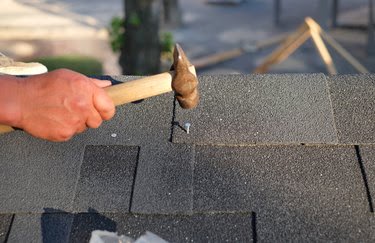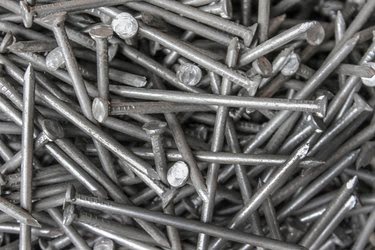Quck answer
There are different types of nails that are used for various purposes. Here is a brief overview of some common types of nails and their uses:
1. Common nails: These are the most widely used nails and are suitable for general woodworking and construction projects.
2. Finish nails: These nails have a small head and are used for finishing work, such as installing trim or molding.
3. Brad nails: Brad nails are similar to finish nails but are thinner and have a smaller head. They are ideal for delicate woodworking projects and attaching thin materials.
4. Roofing nails: These nails have a large, flat head and are designed to secure roofing materials to the roof deck.
5. Masonry nails: Masonry nails are made of hardened steel and are used for fastening wood to concrete or masonry surfaces.
6. Concrete nails: These nails are specifically designed for driving into concrete and are used for attaching wood to concrete or masonry.
7. Upholstery nails: These nails are decorative and are used to attach fabric or leather to furniture.
When using nails, it is essential to choose the right type for your project to ensure proper installation and longevity.
Even though screws have gained popularity over nails in recent years, nails still have their place in home projects. They are preferred for structural work and are ideal for trimwork, flooring, roofing, and paneling, among other tasks. Nails are quick to drive in, provide decent hold, and can be installed to be barely visible if desired. When selecting nails, it is important to consider the appropriate type, size, and material (including special coatings) for the specific job.

Roofing nails are specifically designed for securing shingles to roof decking.
Image Credit:
Vitaliy Halenov/iStock/GettyImages
Nail Sizing
Similar to lumber, nails have their own sizing system. You might have heard the term “penny,” as in “a 6-penny nail.” This is part of an old system that indicates nail length and indirectly its diameter—nails tend to get thicker as they get longer. The penny sizing is denoted by the letter “d,” so nail sizes like 16d, 10d, 4d, etc., are commonly seen. The most common sizes and their lengths include:
- 2d: 1 inch
- 3d: 1 1/4 inches
- 4d: 1 1/2 inches
- 6d: 2 inches
- 8d: 2 1/2 inches
- 10d: 3 inches
- 16d: 3 1/2 inches
- 20d: 4 inches
- 60 d: 6 inches
When nails are not specified using the penny system, their length is simply noted in inches.
Nail Materials
Most nails are technically referred to as wire nails because they are cut from long strands of solid metal wire. The most common nail material is steel. Steel nails for indoor projects may be plain steel (referred to as bright) or they may have a resin or other coating to make them easier to drive into wood; these are often called sinkers.
Ordinary steel nails for outdoor projects—or any application requiring resistance to corrosion—are typically galvanized to prevent rust and corrosion. Smooth galvanized nails are electroplated and offer moderate corrosion resistance. Rough, dull-gray galvanized nails are hot-dipped; these are best suited for outdoor exposure and can be used with pressure-treated lumber (electroplated nails should not be used).
Specialty nail materials include stainless steel, copper, and bronze. Stainless steel nails provide the best combination of strength and corrosion resistance. They are suitable for coastal environments, pressure-treated wood, cedar or redwood (as they will not discolor these woods), or any situation where strength and longevity are crucial. Copper and bronze nails are used for delicate work with copper and bronze materials and for high-end roofing projects.
Common Nails
Common nails are standard, heavy-duty nails used for wood framing and other structural work. They are utilized to construct frames for walls, floors, ceilings, and roofs. As a general guideline, if you are working with “two-by” (1 1/2-inch-thick) lumber, common nails should be used. The most commonly used sizes of common nails are 16d, 10d, and 8d.

Standard nails.
Image Credit:
vav63/iStock/GettyImages
Thin Nails
Thin nails are the slimmer, less sturdy relative of the standard nail. They are typically used for basic wooden constructions involving “one-by” (3/4-inch-thick) lumber or sheet materials like plywood. Due to their slimness, thin nails are easier to drive and less likely to split wood. However, they are also more prone to bending and breaking during hammering. They are suitable for basic construction joints that do not require strong structural support.
Refined Nails
Also known as finishing nails, refined nails are thin with small rounded heads that seamlessly sink into wood. They are the standard choice for various types of wood trimwork, such as baseboards, window and door casing, and crown molding. With careful hammering, you can drive a refined nail flush with the surface or slightly below it using just a hammer. However, it is best to use a nail set, a pointed punch tool that you tap with a hammer, to fully drive the nail slightly below the wood surface. If desired, you can then conceal the nail head and hole with wood putty.
Casing Nails
A casing nail is similar to a finishing nail but has a slightly thicker shaft and a cone-shaped head. It is used for heavier wood stock, such as large baseboards and exterior case moldings on windows and doors, where stronger holding power is required.

Refined nails.
Image Credit:
Walmart
Small Nails
Small nails, often referred to as brads, are similar to refined nails but are typically thinner and weaker. They are ideal for fastening thin strips of trim or for temporarily holding glued wood parts together until the glue dries. Brads can have rounded heads like refined nails or small flat heads. They are commonly used with craft or DIY-size nail guns.
Roofing Nails
As the name suggests, roofing nails are used for roofing purposes. They are short, approximately 1 to 2 inches in length, and have wide flat heads that securely hold down shingle materials without causing damage. Roofing nails are typically made of galvanized steel but can also be aluminum or specialty materials such as stainless steel and copper. Standard roofing nails are designed for composition (asphalt) shingles and wood shingles and shakes. Nails for metal roofing have a neoprene gasket under the head to prevent water from entering the hole created by the nail.
Construction Nails
Durable, hardened-steel construction nails can be hammered into concrete, concrete block, brick, mortar, and other masonry materials. They may have smooth shanks or shanks with rings or flutes for easier driving and increased holding power. Construction nails are useful for attaching objects to brick or block walls, especially if the object will remain stationary and hang straight down, such as a decoration. For structural attachments or objects requiring resistance to pulling out, it is recommended to use concrete screws, which provide better hold and are easier for beginners to install.
Ringed Nails
Various types of nails feature rings, ridges, or barbs on their shanks to prevent them from being pulled out easily (and they certainly hold tight!). Ringed nails, also known as annular nails, are commonly used for installing subflooring, flooring underlayment, house siding, and paneling. Nails driven into lumber are susceptible to being pushed out due to the expansion and contraction forces of the wood. Ringed nails and similar variants help resist this action, ensuring that materials remain securely attached to the supporting lumber.
Drywall nails are a type of nail with a ring-shank, which are utilized to secure drywall panels to wooden framing members. Although these nails are commonly found in older houses, most modern drywall is fastened using drywall screws.

Ring-shank nail.
Image Credit:
Simpson Strong-Tie/Home Depot
Flooring Nails
Traditional cut flooring nails have tapered square shanks, similar to horseshoe nails. They are used to “blind-nail” hardwood floors or to “face-nail” pine plank flooring. They are sold individually (for hand-driving) and in strips for use in nail guns or flooring nailers. Other types of flooring nails have spiral-fluted shanks (for added holding power) and small heads to provide a finished appearance when they are face-nailed.
Duplex Nails
A duplex nail is a nail with two heads. It can be driven all the way down to the first head, ensuring a snug fit, while the second head remains above the surface, making it easy to grip with a hammer claw or pry bar when it needs to be removed. Duplex nails are commonly used in the construction of wooden concrete forms, but they are also useful for any type of rough temporary construction.

Duplex nail.
Image Credit:
GalvanizedNails.net

